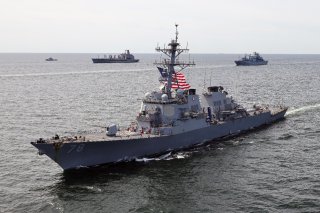The First Constellation-Class Frigate Is Almost Here
Constellation-class ships can detect enemy submarines and help protect convoys, which is one of the frigate’s primary missions.
After years of waiting, construction has begun on the U.S. Navy’s upcoming Constellation-class frigates. Rear Adm. Casey Moton, the program executive officer for unmanned and small combatants, explained to reporters that once Fincantieri Marinette Marine finalized the ship design, the U.S. Navy gave the shipbuilding firm the go-ahead to begin working on the ship.
Still, the design process was not lightning fast—it took the shipyard two years to begin work on the ship, but it is a timeline the U.S. Navy defended.
“It was maturing the design. It is a pretty healthy process that’s got to go on…that’s a fairly lengthy process of going through the functional design where you’re looking system by system. And then it’s a little bit of a spiral, right. If you change some things that they have impact on another [thing],” Rear Admiral Moton explained, according to a report from USNI News.
“It just takes a while to move through that process. In order to complete the design, the shipbuilder has to get all of their major vendors on contract because we’re literally at the level where it’s not just, okay here’s a pump, but we need to know which pump because we got to have the right circuit breakers to feed that pump. It is at quite [a] detailed level. That takes time. And mutually we and the shipbuilder agreed that design maturity was probably the single biggest factor we could do to reduce the risk of production,” he added.
The Constellation-class frigates under development for the U.S. Navy will ultimately number twenty in total. They are the first proper frigates in the U.S. Navy service since the Oliver Hazard Perry-class, a 1970s-era design, the last ship left U.S. Navy service in 2015.
Like the Oliver Hazard Perry-class, the Constellation-class frigates will not be as capable as their counterparts, the Arleigh Burke-class destroyers.
However, the new frigates will carry at minimum 32 Mark 41 Vertical Launch System cells onboard that will afford the ships an over-the-horizon ability to sink enemy ships. Additionally, the Constellation-class ships can detect enemy submarines and help protect convoys, which is one of the frigate’s primary missions.
Though the Constellation-class design is more than 80 percent complete, the U.S. Navy is comfortable with what it has seen to begin construction.
“That’s a percentage beyond just the number. That percentage reflects two things – one is that we wanted to ensure the functional design was largely complete and that’s important because that’s what sets the systems and the equipment selection and all those types of things,” Rear Admiral Moton explained to reporters.
“The other part of it is making sure that the 3D model was complete enough to know that there’s still work that will happen a kind of the modular level, almost compartment level – but making sure that those ship-wide things were mature and stable.”
Caleb Larson is a multimedia journalist and defense writer with the National Interest. A graduate of UCLA, he also holds a Master of Public Policy and lives in Berlin. He covers the intersection of conflict, security, and technology, focusing on American foreign policy, European security, and German society for both print and radio. Follow him on Twitter @calebmlarson.
Image: Flickr/U.S. Navy.

